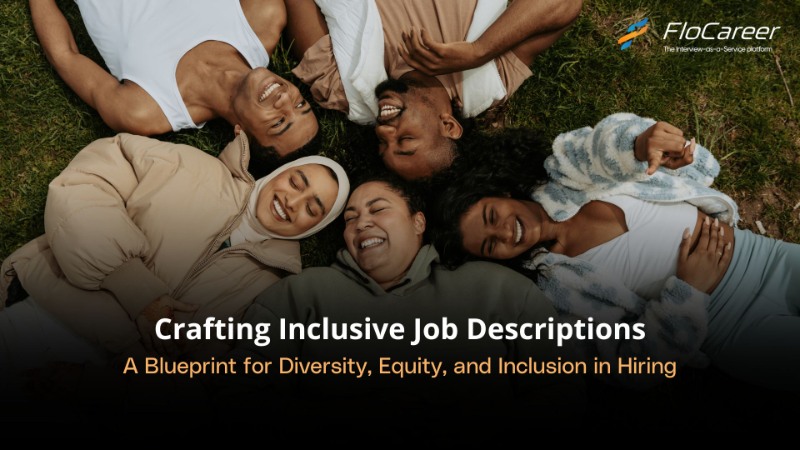Conduct Successful Interviews for Leadership roles: An Interviewer Guide
In a world transformed by the pandemic, where virtual interactions have become the norm, the dimensions of diversity have evolved beyond geographical boundaries. Virtual reality has not only connected people across time zones but has accentuated the significance of fostering diversity and inclusivity in the workplace. As we navigate this new era, the traditional methods of attracting talent demand a reevaluation, making it imperative for organizations to embrace diversity, equity, and inclusion (DEI) as fundamental tenets of their job descriptions.

The Evolution of Diversity in the Virtual Landscape
The virtual revolution has unraveled the tapestry of diversity in ways previously unexplored. It goes beyond merely acknowledging the existence of diverse perspectives; it underscores the need to actively cultivate an inclusive environment that thrives on differences.
The Paradigm Shift in Defining Success
Success, in the contemporary landscape, is not solely defined by individual achievements but by an organization's commitment to recognizing and embracing diversity. This shift underscores the pivotal role that inclusive job descriptions play in attracting a spectrum of talents.
Defining Inclusivity in Job Descriptions
For a job description to be truly inclusive, it must transcend the conventional norms and resonate with a diverse pool of applicants. Forbes.com aptly describes a well-crafted job description as one that "speaks to diverse applicants while being specific about the skill sets required."
Avoiding Biases in Job Descriptions
Inclusivity starts with avoiding biases in language and requirements. An unintentional bias can manifest in specifying traits like a "competitive leader" for a managerial role, potentially excluding exceptional candidates who interpret leadership differently. Recognizing and rectifying such biases is essential for fostering a truly inclusive workplace.
The Applicant's Perspective
Survey data from Glassdoor emphasizes that applicants actively consider an organization's commitment to diversity, equity, and inclusion. A staggering 76% prioritize diverse workplace cultures, while 32% admit they would refrain from applying to a job that lacks diversity.
The Impact of the Pandemic
A survey of 1,100 US employers reveals that 95% are committed to hiring diverse candidates. The pandemic has catalyzed innovative approaches to hiring, with 86% attributing their newfound strategies to the evolving employment landscape.
Crafting Inclusive Job Descriptions: A Strategic Approach
1. Cultural Awareness Survey
Before penning down a job description, conduct a survey to gauge your company's culture. Understanding employee sentiments and areas for improvement provides a foundation for crafting inclusive job descriptions.
2. Essential Requirements
Define the essential requirements for the role meticulously. Avoid the temptation to inundate the description with unnecessary skills that may not be integral to the role or can be acquired through the learning process.
3. Language Accessibility
Steer clear of jargon that may alienate potential applicants unfamiliar with industry-specific terminology. Encourage a learning environment rather than assuming prior knowledge.
4. Impartial Language
Craft job descriptions with impartial language that attracts candidates from diverse backgrounds, ensuring that age, gender, race, and culture are not inadvertently deterrents.
5. Gender-Neutral Language
Eliminate gender-specific language, opting for gender-neutral terms like "they/them," "people," or "employees" to create an inclusive atmosphere.
6. Pronoun Consideration
Incorporate gender-neutral pronouns like "they/them" to replace gender-specific pronouns, fostering an environment where individuals feel acknowledged and respected.
7. Neutral Terminology
Utilize neutral terminology, such as "administrative support" instead of gender-associated terms like "assistant," to broaden the appeal of the job description.
8. Comprehensive Diversity Consideration
Extend the scope of diversity beyond gender to encompass race, ethnicity, religion, disability, sexual orientation, and age.
The Advantages of a DEI Culture
1. Equal Opportunities
Embracing diversity cultivates an environment where all employees enjoy equal opportunities, fostering healthy competition and innovation.
2. Workplace Safety
A commitment to diversity creates a safe workplace where every employee feels secure, contributing to a more productive and harmonious workforce.
3. Inclusive Decision-Making
Inclusion allows organizations to incorporate diverse perspectives in decision-making, promoting creativity and innovative problem-solving.
4. Creative Ascension
An inclusive culture encourages employees to present their ideas, propelling the organization to new creative heights.
Fostering Inclusivity in the Workplace
Management Commitment
Explicit commitment from management to diversity sets the tone for an inclusive culture. This commitment can be communicated through statements, policies, or programs supporting diversity.
Inclusive Training Programs
Conducting diversity and inclusion training for all employees raises awareness and provides essential skills for interacting with colleagues from diverse backgrounds.
Measuring Progress
Regularly measuring progress in creating an inclusive workplace through surveys or feedback mechanisms ensures that inclusion becomes an intrinsic part of the company's culture.
Nurturing Diversity Beyond Job Descriptions
Crafting an inclusive job description is not merely a recruitment strategy; it is an opportunity to collaborate with individuals of diverse expertise and creativity. Organizations must evolve beyond biased approaches to job descriptions, embracing inclusivity as a catalyst for innovation and resilience in an ever-evolving world. At FloCareer, we understand that inclusive hiring practices extend beyond job descriptions. Our Interview Intelligence platform facilitates structured interviews, promoting diversity and inclusion. Explore how inclusive interviews can transform your hiring process.
Check out our latest blog on importance of interview data


